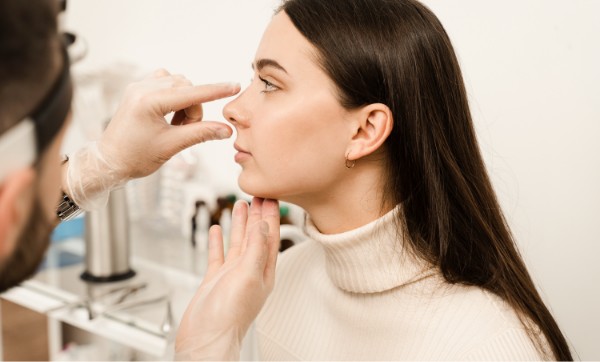
by Guy Lin, M.D., B. Todd Schaeffer, M.D., F.A.C.S. & Moshe Ephrat, M.D., F.A.C.S.
Rhinoplasty is surgery of the nose in which cartilage and bone are reshaped to produce a more aesthetically balanced nose that is in harmony with one’s facial features. Furthermore, it is crucial to maintain the function of the nose after rhinoplasty. Oftentimes, nasal obstruction is addressed in the same sitting including surgery for a deviated nasal septum, turbinate hypertrophy, chronic sinusitis, or collapse of the nasal valve due to weakness of the tip support structure. Usually there is a little discomfort with nasal surgery. Oral medication will be prescribed to help with any discomfort. A small splint will be placed on the nose immediately after the surgery and remain for one week, at which time the splint will be removed and the nose cleaned. There may be some bruising and swelling around the eyes. Approximately 80% of the swelling is gone after two weeks; another 10% after two months. The tip of the nose may retain swelling longer and continued improvement in the tip can be seen over the next several months. There may be some temporary numbness of skin of the nose, which improves as swelling improves.
Most patients can be seen in public in one week after the splint is removed. It is important to avoid strenuous activity for two weeks. At this time you can gradually work back to your usual exercise routine. Contact sports should be avoided for at least two months. The individual goals of nasal surgery can usually be obtained in one surgery. There are times when a "touch up" procedure needs to be performed. Noses that have been broken, crooked noses, and noses that have had previous surgery are generally more difficult to correct. These situations are more likely to require a revision procedure.
Being able to see what your face might look like after rhinoplasty can be very useful, and computer imaging makes this possible. Computer images help to ensure that you and your doctor are on the “same page” with respect to your goals of surgery. Computer imaging is not a guarantee of results, but a useful tool for demonstrating possible enhancements to the nose and face. Bleeding, infection, unfavorable scarring, asymmetry and persistent nasal deformity are the most common risks of rhinoplasty surgery. These risks, as well as goals, and a detailed customized plan for you will be discussed during your consultation.
Dedicated to Providing Convenient and Exceptional Care

Less Sick Days, More Living

